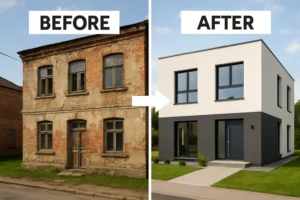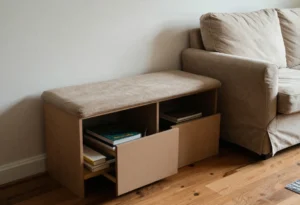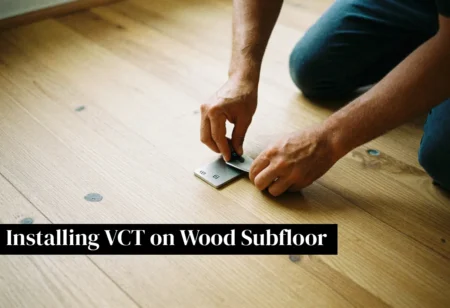Selecting new flooring can be an exciting yet daunting process. With so many options to choose from, how do you know which flooring type is best for each room in your house?
The flooring you pick can dramatically impact the aesthetic, functionality, and value of your home. That’s why it’s crucial to think through your choices carefully and choose materials suited to the needs of each space.
In this guide, we’ll walk you through the key factors to consider when outfitting the floors throughout your home. Let’s explore the unique considerations for popular living spaces and examine the pros and cons of various flooring materials.
Armed with the right insights, you can make informed decisions and find flooring solutions tailored to your lifestyle, budget, and design vision. With thoughtful planning and smart material selections, you can craft interiors that are both beautiful and highly livable for years to come.
An Introduction to Types of Flooring
Before examining flooring options room-by-room, let’s get familiar with the most popular categories of flooring and their key characteristics.
Hardwood Flooring
Hardwood floors are among the most desirable and traditional flooring choices. Constructed from oak, maple, cherry, and other wood species, hardwood offers a timeless, elegant look.
Pros
- Beautiful and natural aesthetic
- Variety of wood grains and colors
- Durable and long-lasting
- Can be refinished and restored
- Adds value to home
Cons
- Expensive upfront cost
- Can be damaged by moisture
- Prone to scratches and dents
- Requires regular maintenance
Laminate Flooring
Laminate flooring provides the visual appeal of hardwood without the hefty price tag. Laminate features a photographic layer under a clear protective coating to mimic wood’s look.
Pros
- Affordable alternative to hardwood
- Wide range of styles and colors
- Easy DIY installation
- More dent and scratch resistant than hardwood
- Does not fade from sunlight
Cons
- Not as durable as real wood
- Cannot be refinished or repaired
- Not moisture resistant
- Can appear fake next to real wood
Vinyl Flooring
Vinyl flooring comes in both sheet and tile formats. It offers good durability and water resistance at a budget-friendly price point.
Pros
- Extremely affordable option
- Available in tile and sheet formats
- Easy to clean and maintain
- Very moisture resistant
- Good for basements and bathrooms
Cons
- Less durable than other materials
- Can scuff, tear and stain
- Sheet vinyl seams may show
- Can off-gas VOCs initially
Ceramic and Porcelain Tile
Tile flooring provides an elegant, easy-to-clean option well-suited for kitchens, baths, and laundry rooms. Porcelain tiles offer greater durability than ceramic ones.
Pros
- Highly water resistant
- Easy to clean and sanitize
- Durable and scratch resistant
- Variety of colors, shapes, and textures
- Doesn’t fade or stain easily
Cons
- Hard, slippery surface
- Grout lines prone to staining
- Breakable if dropped
- Can be cold underfoot
Natural Stone Tile
Mined from quarries, natural stone tile comes in options like marble, granite, slate, and travertine. It’s prized for beauty but requires sealing.
Pros
- Elegant, upscale aesthetic
- Each tile has unique natural patterning
- Variety of stone types with different looks
- Durable and long-lasting
Cons
- Expensive upfront cost
- Requires sealing to prevent staining
- Slippery when wet
- Challenging DIY installation
Carpet Flooring
Carpet provides softness and warmth ideal for bedrooms, living rooms, and finished basements. Fibers like nylon and polyester wear well.
Pros
- Soft, warm, and comfortable
- Offers sound dampening
- Range of colors, textures, and styles
- Budget-friendly option
- Easy DIY installation
Cons
- Traps dust, dirt, and allergens
- Prone to staining and matting
- Not moisture resistant
- Replacement required every 5-10 years
Now that we’ve surveyed the flooring field, let’s examine how to select the optimal flooring by room based on the needs of each space.
Choosing Flooring for Living Spaces
Living rooms, family rooms, dens, and bedrooms see a lot of daily foot traffic and require flooring that’s both attractive and comfortable. These rooms call for materials that are soft underfoot yet durable.
Living Room Flooring
As a central gathering place and showcase space, your living room deserves beautiful, distinctive flooring. Many homeowners opt for luxurious carpeting or polished hardwood floors in formal living rooms. But alternative options abound:
- Hardwood: Classic and elegant wood flooring offers timeless appeal. Opt for a glossy finish for a formal look or a matte finish for something more relaxed. Durable exotic woods provide visual interest.
- Laminate wood: For a budget-friendly wood look, laminate replicates the beauty of hardwood at a fraction of the cost. Advanced printing technology produces realistic wood grains and textures.
- Carpet: Plush wall-to-wall carpet adds warmth and softness underfoot. Look for durable, stain-resistant fibers suitable for high traffic areas. Patterned carpets can make a design statement.
- Tile: For a sleek, contemporary vibe, porcelain or ceramic tile adds gleaming finish. Opt for larger tiles or natural stone for drama. Use area rugs over tile to define seating spaces.
- Vinyl plank: Vinyl plank flooring mimics hardwood with added durability and moisture resistance. Mix plank styles for a custom look.
Bedroom Flooring
Bedrooms should invite relaxation and rejuvenation. As private retreats, these spaces call for flooring that contributes to a peaceful vibe. Top options include:
- Carpet: The best choice for comfort and sound absorption, carpet helps bedrooms feel tranquil and cozy. Look for soft, dense padding for extra cushioning.
- Hardwood: Timeless and elegant, hardwood suits traditional and modern bedrooms alike. Use area rugs to define spaces around beds or sitting areas.
- Laminate: Affordable laminate flooring resists scratches, stains, and moisture damage. Choose textures that mimic luxurious wood types.
- Vinyl: Vinyl plank flooring offers the allure of hardwood with superior durability and cushioning. New print technologies create stunning visuals.
- Cork: Naturally sound absorbing, antimicrobial cork adds a relaxed, earthy feel. Opt for sustainable harvested cork tiles or planks.
No matter your style, aim for bedrooms floors that feel great underfoot and contribute to an ambiance of relaxation.
Selecting Flooring for Wet Areas
Kitchens, bathrooms, mudrooms, laundry, and utility spaces all contend with potential flooding, spills, and moisture. Choosing water-resistant flooring is key for both functionality and longevity.
Kitchen Flooring
As the epicenter of spills, splashes, and breakages in the home, kitchens require ultra-durable, unfussy floors that are easy to clean. Smart options include:
- Porcelain or ceramic tile: Impervious to water and stains, porcelain tile withstands heavy use. Mosaics, large tiles, or natural stone create style.
- Quarry tile: Made from natural clay, quarry tile resists chips, cracks, and heat. The small tiles allow for replaced of damaged sections.
- Linoleum: Waterproof and ecologically-friendly, linoleum resists spills, scuffs, and scratches. Sheet linoleum is seamless; tile format has grout.
- Luxury vinyl tile: Affordable, stylish, and easy to install and clean. New wood and stone looks mimic pricier materials.
- Concrete: Sealed and stained concrete floors offer an industrial vibe. Integrated heating systems provide comfort.
For active kitchens, always opt for ultra-durable, water-resistant flooring that can withstand heavy daily use.
Bathroom Flooring
Given the splashing, humidity and potential for leaks, waterproof bathroom flooring is a must. Choose materials that offer both style and impeccable functionality.
- Porcelain tile: Impermeable and easy-to-clean, porcelain tile comes in numerous colors, shapes, textures. Use mosaics or large tiles.
- Natural stone: Slate, granite, and travertine add luxurious texture. Make sure tiles have a textured finish for traction. Seal regularly.
- Glass tile: Resilient, waterproof and easy to clean, glass tile adds gleaming finish to modern baths. Penetrating sealers keep natural stone less slippery.
- Cork: Naturally antimicrobial, water-resistant cork offers a warm, quiet flooring option. Opt for treated cork tile or plank with polyurethane coating.
- Vinyl sheet: Seamless vinyl sheet flooring resists water damage and hides subfloor imperfections. New innovations provide stone and wood looks.
- Rubber tile: Made from recycled tires, rubber tile is comfortable, durable, and waterproof. It reduces injuries from slips or falls.
- Radiant heated floors: Integrated radiant heating under flooring materials like tile or stone keeps feet warm on chilly mornings.
Proper bathroom flooring should offer exceptional water resistance, durability, and slip resistance. Prioritize safety and easy maintenance in these hardworking spaces.
Flooring for Basements, Garages and Laundry Rooms
Basements, garages, laundries and mudrooms contend with temperature swings, humidity, and potential flooding. Choosing the right flooring is key to handling demanding conditions.
Basement Flooring
With moisture management the top concern, certain water-resistant flooring materials are well-suited for basements:
- Engineered wood: More stable than solid wood, engineered wood resists moisture related warping. Opt for click-lock planks for DIY-friendly installation.
- Laminate: Affordable, realistic wood-look laminate flooring installs easily. Look for stain and fade-resistant styles rated for basements.
- Vinyl plank: Available in wood or tile looks, vinyl plank floors are 100% waterproof and easy to install, even on concrete.
- Ceramic tile: Impervious to water, ceramic tile works great over concrete slabs. Use a special mortar and grout to allow shifting.
- Seamless epoxy: Applied as a coating, epoxy creates a glossy, seamless basement floor. Embed color chips or quartz for decoration.
Proper drainage, moisture barriers, and vapor emission retarders under the slab are musts!
Garage and Laundry Flooring
Utility spaces like garages and laundries require heavy duty floors able to withstand moisture, chemicals, oil and temperature fluctuations. Great options include:
- Poured epoxy: Tough, glossy, and chemical resistant, poured epoxy creates a seamless floor. It withstands hot tire pickup and salt damage from wintry roads.
- Quarry tile: Made for demanding conditions, quarry tile resists moisture, spills, and temperature extremes. It’s easy to hose clean.
- Industrial vinyl tile: Affordable and waterproof, vinyl composite tile is extra rugged yet comfortable underfoot. Easy to swap out sections as needed.
- Sealed concrete: For a basic inexpensive option, properly sealed and coated concrete can work well. Be sure to address cracking or other slab issues first.
Prioritize flooring that can withstand messy work, water, and heavy objects in demanding utility areas.
Factors that Influence Flooring Decisions
Beyond location, several other key considerations influence which flooring types work best in each part of your home:
Budget
Flooring comes in a very wide range of price points. Measure spaces and research material costs to get estimates for projects both big and small.
While you don’t want to settle for poor quality, attractive and durable floors are available even on tight budgets if you choose wisely.
Style of Home/Overall Decor
Match flooring aesthetics to the style of your home for a cohesive look. Contemporary homes tend to feature sleek hard surface flooring for example, while traditional homes gravitate toward classic hardwoods and ornate tile designs.
Coordinate your color scheme and flooring for a put together vibe.
Lifestyle and Family Needs
Factor needs like noise reduction, pet-friendly durability, or elderly safety into the equation. For active families,prioritize scratch resistant surfaces and stain guard treatments.
Choose cushioned, supportive materials like cork or vinyl for basements or workshops where you’ll stand for long periods.
Use by Room
Consider the different ways each room gets utilized. For dining rooms, an easily cleanable surface is essential for managing food spills and crumbs.
Bedrooms should promote relaxation so carpets or quiet cork floors make sense. Pick slip-resistant tile for bathrooms to prevent falls.
Traffic Volume
Opt for extra durability in spaces that see the most feet or furniture traffic. For example, hardwood may not withstand heavy use in a busy hallway or playroom as well as stone tile or commercial grade sheet vinyl.
Factor in both human footsteps and wear from desk chairs, appliances, pets, or kids’ toys dragging.
Ease of Cleaning/Maintenance
Keep upkeep requirements in mind, as some floors demand frequent sweeping, mopping, vacuuming or refinishing. Those with busy lives and aversions to housework may gravitate toward low maintenance options like vinyl, porcelain tile, or hardwood with protective coatings.
Professional Installation Recommendations
While handy homeowners can tackle some DIY flooring projects successfully, complex jobs are best left to flooring installation professionals. Experts have specialized tools and skills to handle the tricky aspects.
Consider pro help for:
- Hardwood installation and sanding
- Intricate tile layouts
- Natural stone and its heavy cuts
- Large vinyl sheet flooring rolls and seams
- Leveling or repairing damaged subfloors before installing new floors
Reputable flooring companies will include services like:
- Tearing out and disposing of old flooring if needed
- Moving appliances and heavy furniture
- Thorough subfloor inspection and preparation
- Moisture testing of concrete before installation
- Evening out minor subfloor imperfections for flat floors
- Premium adhesives, underlayments and finishes
Never install wood, tile or vinyl over damaged, uneven or moist subfloors. Address underlying issues to prevent floors from failing prematurely.
Professionals also know all the tricks of the trade for lovely finished results. Leave it to the experts and avoid backaches, frustrations and disappointments!
Regular Flooring Maintenance
All flooring requires some degree of regular care and maintenance to look its best and maximize longevity. Follow the manufacturer’s recommendations for your specific flooring type.
Below are some general tips by category:
Hardwood
- Sweep or vacuum to remove gritty dirt
- Damp mop with hardwood cleaner
- Avoid excessive water/liquids
- Use felt pads under furniture legs
- Refinish occasionally
Laminate
- Sweep, vacuum or dust mop
- Damp mop with laminate cleaner
- Never wax or refinish surface
- Don’t let spills sit
Tile and Stone
- Sweep then wet mop for deeper clean
- Use pH neutral stone cleaner
- Re-seal natural stone annually
- Check for cracked or loose tiles
Carpet
- Vacuum high traffic areas twice weekly
- Periodically spot clean stains
- Shampoo every 12-18 months
- Replace padding with carpet
Vinyl
- Sweep or vacuum loose debris
- Damp mop with vinyl floor cleaner
- Avoid abrasive cleaners
- Don’t wax floors
Remember, occasional deep cleaning like steam mopping goes a long way too. Invest time keeping floors spotless and you’ll safeguard their good looks.
Environmental Health Considerations
In addition to appearance and functionality, the environmental impact and indoor air quality of flooring are important considerations for homeowners.
There are great eco-friendly flooring options available both natural and man-made. Do research to understand the sustainability and off-gassing potential of products that interest you.
Some pointers:
- Solid hardwood from responsible sources is biodegradable and recyclable.
- Cork and bamboo are renewable resources but confirming they are sustainably harvested is key.
- Look for low or zero VOC vinyl, linoleum and laminate flooring.
- Natural linoleum is made from renewable ingredients like cork dust and linseed oil.
- Porcelain, glass and terrazzo tile contain high recycled content.
- Carpet padding made from recycled fibers is available. Opt for hypoallergenic carpet.
- Avoid PVC vinyl products which can off-gas harmful chemicals. Water-based polyurethane is safer.
An eco-friendly home starts from the ground up with flooring that aligns with your green values. Keep indoor air fresh by selecting healthier flooring materials.
Concluding Thoughts
Selecting the optimal flooring involves careful consideration of factors ranging from style, durability, comfort, maintenance and environmental impact.
Thinking through the unique needs of each room along with your family’s lifestyle and priorities will guide you to make the smartest choices.
By tailoring flooring selections to how different rooms are used, you can create a home that is both beautiful and supremely livable. Striking the right balance between practicality and aesthetic appeal takes forethought but is worth the effort.
Keep in mind future plans as well. Will you be selling soon or staying long-term? Do you expect major changes in how you use rooms? Address likely developments now so flooring continues meeting your needs down the road.
While flooring projects require an initial investment, quality materials properly installed will provide many years of reliable service and enjoyment. Avoid cutting corners or you may end up paying more over time.
With some thoughtful planning, research, and expert installation, you can outfit your home with floors that check all the boxes in terms of comfort, functionality and wow-factor curb appeal.
Your floors serve as the foundation for rooms where life unfolds daily. Take your time and choose wisely – you’ll reap the benefits every time you walk through your home.



